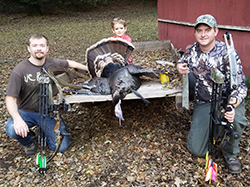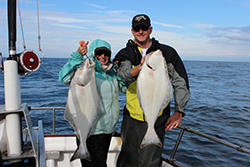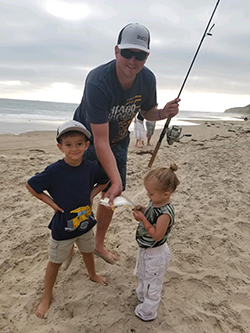
In the Fish family, hunting and fishing is a family affair. Max Fish, right, accompanied by his son and brother, pose for a photo after a successful archery hunt for wild turkey.

Fishing in Alaska, Max and his wife, Carly, show off their catch.

As a father of two young children, Max makes it a priority to take his kids fishing, hunting and into the outdoors every chance he gets. Max and his son, Ryland, and daughter, Ellie, spend time surf fishing in Southern California.
There is not a more appropriately named employee anywhere within CDFW than Max Fish. An environmental scientist with the Inland Fisheries Assessment and Monitoring Program, Max is tasked with, well, helping to maximize fish and fishing opportunities within California’s inland lakes and reservoirs. He is based in West Sacramento.
The tools of his trade include the heavy duty, Smith-Root SR18 electrofishing boat he captains, a research vessel that can pump 170 to 1,000 volts of electricity through the water, temporarily stunning fish to the surface in order to survey populations and assess health in the state’s inland waters.
From Kokanee Salmon to crappie and catfish, Max works with more than three dozen inland fish species found in California. He also collects and analyzes all the data submitted by tournament anglers and fishing contests throughout the state.
Born and raised in Palo Alto, Max earned a bachelor’s degree in wildlife and fish conservation biology from UC Davis and joined CDFW shortly after graduating in 2007.
You’ve seen the data from all the big bass tournaments. Where would you send someone interested in catching a really big black bass?
We have several species of black bass in California, which are largemouth, smallmouth, spotted, Alabama and redeye.
My area of expertise is really in northern California. I’d start with any of our central California lakes that have Kokanee Salmon populations. California holds the world record for Alabama Bass out of New Bullards Bar Reservoir (Yuba County). For awhile, it seemed like New Bullards Bar would kick out a new world record bass every season. Right now, the world record fish is sitting at just about 11 ½ pounds.
For Largemouth Bass, we don’t have the world record but we’re close. Of the top 25 largest Largemouth Bass ever caught anywhere in the world, 20 have come from California – all from Southern California lakes. In northern California, it’s hard to beat the quality of large fish in Clear Lake (Lake County) and the California Delta.
Tell us about the special projects you’re involved with.
I work on a program to promote and expand Sacramento Perch. Sacramento Perch are the only species of sunfish native to California. They are the only native sunfish west of the Rockies. They are now extirpated from their native range in California, which was the Delta, but we’ve got them in about 20 lakes where they’ve been translocated.
We’ve been trying to promote the Sacramento Perch on a variety of fronts – for private industry, for private stocking and recreational angling. There are a lot of private landowners who are really interested in native fish, especially native gamefish that are warm-water tolerant. There’s really only one – and that’s the Sacramento Perch. So we’ve been working on that front. We’ve collected all the tissue samples to identify which populations are more genetically robust, more diverse and suitable to create new populations.
Can Sacramento Perch be reintroduced into the Delta or are there too many other predatory fish there now?
The literature shows that predators aren’t as big of a problem as are competitors. Sacramento Perch evolved in California when the main competitors on the valley floor were Pikeminnow and Steelhead. All the introduced sunfish from the Midwest had dozens of competitors they had to compete with so they developed breeding strategies and feeding strategies that are really aggressive.
Sacramento Perch just don’t have that. So when you put them in an environment with a bunch of Green Sunfish or Bluegill or Redear Sunfish, they just seem to get pushed out over the course of a few years. So that’s been, I think, by far the biggest challenge in trying to expand them. All of our surface waters in the Sacramento Valley and the foothills have sunfish in them.
But when you talk to people about Sacramento Perch, they get super excited to hear about a native gamefish that’s warm-water tolerant. You can stock them in a pond and they will do great. They will survive under ice. As far as environmental conditions go, they are super tolerant.
What’s happening with California’s landlocked salmon such as Kokanee and Chinook?
One of the things I’m doing now is a mark and recapture study of Kokanee Salmon. Last year, we began marking fish by clipping the adipose fins of all the Kokanee we stocked into Stampede Reservoir (Sierra County). Stampede Reservoir is our brood stock water for Kokanee Salmon. In lakes like Stampede where there is natural recruitment and a stocking allotment it’s tough to make management decisions when you don’t know what relative contributions either of those make to the fishery. By fin-clipping those fish when we stock them, we can see how many return to spawn or how many show up in anglers’ catches. We can see the relative number of hatchery fish versus natural fish and determine if we are stocking too many, too few and adjust our stocking accordingly. In 2019, we released marked Kokanee into New Melones Reservoir (Calaveras/Tuolumne counties).
If you had free reign and unlimited funding, what scientific project would you most like to undertake?
I’d do two. One is create a Sacramento Perch broodstock facility. Like I said, we have an idea from our genetic work on where to get our broodstock, but there is the question of where to put them. We’d like something on state lands that we can control. A natural pond could function as a production facility as well as a grow-out facility but finding something that doesn’t already have non-native fish and has a secure water source that is not going to go dry is a challenge. A solar-powered well would be perfect. We could dig a pond, put in a well, know that we would have good water – but all of that costs money. We are headed there but it is slow going.
I’d also expand our Kokanee mark and recapture study. Instead of fin-clipping 40,000 Kokanee a year, I would love to do all of the Kokanee we plant – but that’s the expensive part. Collecting the data on the back end isn’t too bad. We use creel surveys of angler-caught fish. At least in Stampede, that’s where we collect our eggs so we are seeing all the fish that come up the river to spawn anyway. Maybe we wouldn’t have to fin-clip all of the fish but at least the ones we stock into lakes with naturally reproducing populations. We could get a lot more data a lot more efficiently.
What advice would you give a young person today thinking about a career in natural resources?
If you haven’t already, read “A Sand County Almanac” by Aldo Leopold. That book had an impact on me and still does to this day. I think it’s a valuable read for anyone going into this field.
What about the book spoke to you?
It’s just the way Aldo Leopold viewed the natural world and the way we as human beings fit into it.
Away from work, where are we most likely to find you?
Usually fishing, hunting, backpacking or otherwise spending time with family. It depends on the season. In the spring, I really enjoy turkey hunting and fishing – stripers in the river, and Kokanee, bass and crappie in lakes. In the fall, I’m deer hunting, duck hunting, crabbing, and fishing for rockfish.
I hunt and fish for food – not out of necessity but because I feel more integrated into the natural world and more connected to the earth. I think it’s a uniquely satisfying experience in our society that’s increasingly disconnected from the earth. It’s what Aldo Leopold wrote a long time ago that holds true today: “There is value in any experience that reminds us of our dependency on the soil, plant, animal, man food chain.”
CDFW Photos. Top Photo: Max Fish captains a CDFW electrofishing boat in the Sacramento-San Joaquin Delta in January to help collect Largemouth Bass for live display at the International Sportsmen’s Exposition in Sacramento in January.